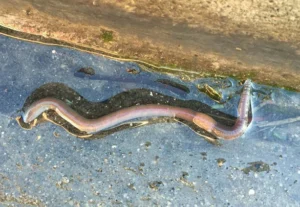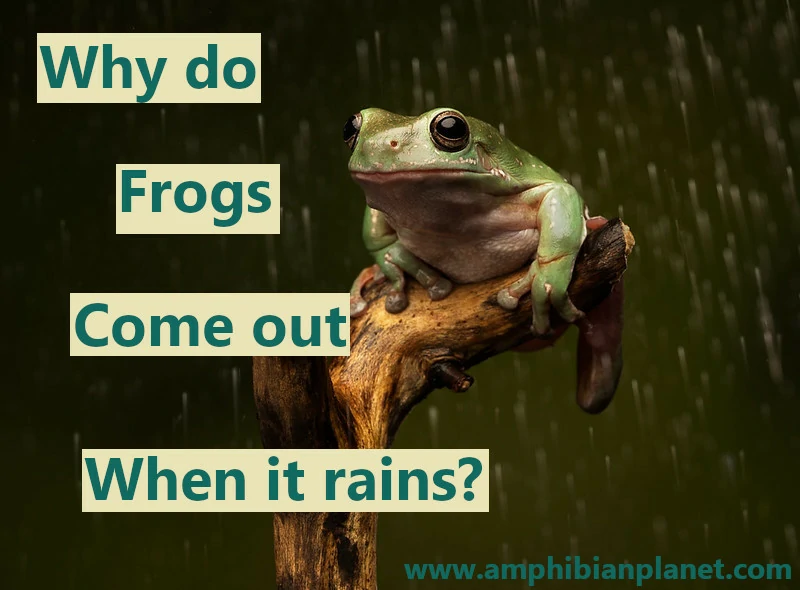Frogs are amphibians, which means they live part of their lives in water and part on land. Many frogs love to hang around ponds and other water bodies where they can hydrate, and keep their skins moist. However, in moist, humid weather, frogs often venture further away from their natural habitats and often wander into people’s backyards.
Frogs come out in the rain because they like the wet, cool, environment. Wet weather means frogs can roam around without the risk of their skin drying out. Worms, snails, slugs, and many bugs are also more plentiful in wet weather, so frogs can feed without much effort.
In addition, the breeding season for frogs is largely stimulated by rainfall, higher temperatures, and the availability of food. Rain floods ditches, and fills ephemeral ponds and other water bodies where frogs can lay their eggs.
Some frogs can breed year-round as long as there is enough rain, and the temperatures are warm enough for their tadpoles to develop.
Frogs Like Humid Environments
Frogs love cool, humid environments. They usually hang around shaded areas near ponds, swamps, streams, lakes, and other water bodies.
When it rains, the weather is usually cloudy, and moist – creating the perfect environment for frogs to come out, and wander further away from their typical habitats.
Frogs have permeable skin that they keep constantly moist by secreting a mucous coating. In dry hot weather, their skin can easily dry out, which can be fatal to them.
However, when it rains, the humid weather and higher moisture content in the air mean frogs’ skins do not dry out as easily. If they start to dry out, they can rehydrate and keep their skin moist.
In addition, some predators are less likely to be active in rainy weather, creating a safer environment for frogs.
Frogs Can Find Food More Easily in the Rain
When it rains, snails & slugs come out, and lots of earthworms come to the surface. Exposed earthworms or snails are an easy meal for a hungry frog.
If you ever take time to “dissect” and inspect the droppings of frogs, during the wet season, you may find undigested, broken-up snail shells.

Plus, raindrops often hit flying bugs along the way, which knocks them out of the air and onto to ground, making them easy targets for frogs.
Frogs Can Hydrate in the Rain
All animals need water to survive. Rain creates puddles on the ground where frogs can soak and hydrate.
That said, it’s important to note that frogs do not drink through their mouths as we do. Instead, they drink by absorbing moisture or water through a specific area of the belly skin called the “drink patch”.
The drink patch has a very large network of capillaries close to the skin surface, and water is absorbed through the skin via osmosis.
Rain Signals the Mating Season for Frogs
As earlier mentioned, the breeding season for frogs is largely stimulated by rainfall, higher temperatures, and the availability of food.
When it rains, the wet, cool environment, and increased availability of food, creates the perfect conditions for frogs to breed.
This is also why you will often hear frogs croak in rainy weather. The croaking is actually male frogs trying to attract female frogs of the same species to mate with.
In addition, rain fills up ditches and ephemeral ponds, where frogs can lay their eggs.

Some frogs are not picky about the water bodies they lay their eggs in. They will lay their eggs in virtually any small standing body of water, as long as it’s free of predatory fish.
For example, Cuban tree frogs are known to lay their eggs in ponds, ditches, drainage systems, water tanks, and even in swimming pools. Their eggs have also been found in old ice chests, children’s wading pools, and buckets half full of rainwater.
Pacific tree frogs are also known to use almost any type of still or slow-flowing water for breeding. Gray tree frog eggs have even been found in bird baths and many other unconventional places.
Boreal chorus frogs are also known to lay their eggs almost anywhere there is standing water – including in flooded potholes.
Frogs Can Travel Further in Rainy Weather
Frogs are amphibians, which means they have permeable skin. They keep it constantly moist by secreting a mucous coating.
When the weather is dry, it also means the moisture content in the air is low, and frogs’ skins can dry out easily. But in rainy weather, there is a higher concentration of moisture in the air, meaning their skins do not dry out as easily.
Frogs can move around freely and travel to new areas in rainy weather, without worrying about keeping their skins moist.
Frogs Can Migrate to Their Breeding Ponds in Rainy Weather
On the first warm, rainy night of spring, the rain will lure out hibernating frogs (such as wood frogs & spring peepers), salamanders, and other amphibians. This is usually before the snow is completely gone and when pools are still partly frozen.
Once they emerge, frogs will migrate to wetlands with deep enough water where they can breed. This mass migration is often referred to as “the big night”.
In some towns, people close roads and gather to watch thousands of frogs and salamanders on their breeding migration.
During this migration, frogs can travel significant distances, sometimes up to half a mile.
Frogs Can Breathe Easily in Rainy Weather
Although frogs have lungs, they also breathe through their skin and thin membranes in their mouth and throat to get extra oxygen.
The skin contains a large network of capillaries and other blood vessels close to the surface. The oxygen that comes in contact with their skin and membranes is absorbed into the bloodstream via diffusion.
At the same time, carbon dioxide from the bloodstream passes through the skin and membranes and is diffused into the atmosphere.
This process of “skin breathing” is known as cutaneous respiration, and is very similar to what happens inside of our lungs.
To efficiently breathe, frogs have to keep their skin constantly moist. They can only absorb oxygen through their skin if the skin stays moist. If it dries up, they can suffocate and die.
The high environmental humidity in rainy weather means frogs can breathe easily and efficiently, without their skin drying out.
Frogs Can Cool Off in Rainy Weather
Frogs are ectothermic (cold-blooded) animals, which means they cannot regulate their body temperature. Their body temperature changes with that of their surroundings.
When it’s warm, their bodies soak up the heat, and their body temperature rises. When it’s cooler, their body temperature falls.
In other words, they depend on their environment to keep them comfortably cool or warm.
As the temperature changes at different times of day and night, they move around in their environment to regulate their body heat.
When their body temperature is low, they move into the sun to warm up, when it is high, they move to the shade or cool water to cool down.
During the winter, frogs will hibernate (technically, they brumate), to protect themselves from the freezing temperatures.
In the summer, if the weather gets too harsh, frogs will find a cool, moist place and estivate (think of it as some sort of ‘summer hibernation’) as they wait for the rain to come and the temperatures to drop.
When the summer rain finally comes, frogs will emerge from estivation, and come out to cool themselves by swimming in the puddles. This can be very refreshing, especially for frogs that don’t live near a pond or another body of water where they can swim in.
Commonly Asked Questions:
Do frogs come out in the rain? Frogs come out in the rain because the cool, wet weather allows them to roam freely without risking their skin drying out. Worms, snails, and many bugs are more plentiful in the rain, so frogs come out to feed. Also, rainy weather often signals the breeding season, so frogs will come out to mate.
Where do frogs come from when it rains? Frogs are often found in shaded areas near water bodies such as ponds, swamps, streams, or lakes, where they can keep their skins moist. Some also hide in cool, moist caves, under moist leaf litter, and other debris. When it rains, the wet environment means frogs can wander further away from their habitats.
Why do toads come out when it rains? Toads come out when it rains for the same reasons frogs do. They like the cool, wet environment, and increased availability of worms, snails, and bugs. They also come out to mate and lay their eggs in ditches, and ponds flooded with rainwater.
Why do frogs croak after it rains? Rainy weather creates a good environment for frogs to mate and lay their eggs. Frogs croak after it rains because they are trying to attract a mating partner of the same species to reproduce with.
Conclusion
Although most frogs love to hang around water and wait for the rain before they reproduce, some frogs such as the common coqui reproduce away from water.
These frogs do not wait for the rain before they mate or lay their eggs – they can breed over the entire year.
The eggs are laid in tree holes, the petioles of rolled palms, and even in abandoned bird nests. Since the eggs are not laid in water, their young do hatch as tadpoles.
Rather, they hatch as fully developed froglets (young frogs) that will live their entire lives on land.
Photo credit: Steve Walker (CC BY-ND 2.0).


